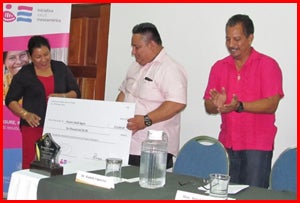
Publicado por Guardian Belize
Belize’s Ministry of Health will be embarking in the next few weeks into a third phase of the Salud Mesoamerica Initiative. This third phase has been approved by a consortium consisting of the Belize Ministry of Health, the Bill & Melinda Gates Foundation, Instituto Carlos Slim de la Salud and the Ministerio de Asuntos Exteriores y de Cooperacion from Spain-- under the Inter-American Development Bank IDB umbrella.
Honorary Belizean Dr. Ignez Tristao, Social Protection and Senior Specialist at the Inter-American Development Bank, after a long flight and a few hours of stay in Belize, told the Guardian that this third phase, “…has some of the same indicators that we had in the second operation, but with higher targets and it also includes new areas of work like improving preconception care in Belize and also early screening for cervical cancer.”
Dr. Ramon Figueroa, Chief Executive Officer in the Ministry of Health has also reinforced that this third phase has the potential of benefiting 60,000 women and children as the Ministry of Health moves it’s manpower into the Central Region and becomes determined “…to focus in the South.”
Dr. Figueroa has also said that in this new venture in 52 different villages, it will be more of a preventative typen interventions, educating younger women in the pre-conception phase. Importantly it will look at building up their knowledge in terms of what are the risk factors in pregnancy and child rearing. To do so the Ministry of Health will be relying on experiences, in getting community involvement, such as those learnt during the first and second phase of the Salud Mesoamerica Initiative, which began in 2013.
As we discovered in the last issue of the Guardian, Belize is one of two of the eight Mesoamerican countries that has met ten health indicators and as a result was rewarded with one hundred and fifty thousand U.S dollars from the IDB run partnership. Dr. Ramon Figueroa had explained at the National Vaccine Storage Facility last Wednesday how those funds will be distributed.
Some of these funds will be invested at the Valley of Peace Health Center and at the Maternity Ward at the Western Regional Hospital. In the San Ignacio catchment area, funds will also be placed at the Seven Miles Community Health Post, the Mopan Poly Clinic, the Georgeville Health Center and the San Ignacio Community Hospital.
In the Northern Health Region, where community health workers and medical teams worked in concert to achieve great result in health indicators under the Salud Mesoamerica Initiative, funds will be apportioned to the August Pine Ridge, Caledonia, Guinea Grass and San Felipe Health Centers. It is at these health centers where health personnel are on standby for any emergency in the furthest reaches of our communities.
But more importantly as Belize goes into the third phase, $41,447.00 will be allocated for project vehicles to assist in mobility.
One of the objectives of the Salud Mesoamerican Initiatives as a regional project was to improve the coverage of quality maternal, newborn and child health care services, with a concentration in the Western and Northern Health Region, which essentially covered three out of the six Districts of Belize. The initial expectation was that each phase of the project would be completed in 18 months, with the second phase having just ended last month. The first phase had focused on the provision of select maternal and neonatal care services, where there had been a remarkable performance of indicators.
Quantifying these health indicators in Belize during the first and second phase was the Institute for Health Metrics Evaluation, which is the most renown institution in the World for measuring health indicators.
As described by Dr. Ignez Tristao, “…five years ago we have jointly decided to work together to accelerate ten critical health indicators for women and for children, today five years after that what we see is a tremendous improvement, and what that means for the Ministry of Health, it means that right of a hundred fifty thousand U.S dollars, but more important than that, it actually means that more than 30,000 [women] and children are receiving good care, very effective care.”
Among that care was the application of the hormone Oxytocin, which “….speeds up delivery and reduces the risk of heavy bleeding during childbirth…”, says Dr. Cassandra Rogers, Country Representative for the IDB.
Fundamentally, the use of Oxytocin increased in Belize from 34% to 98.7% Oxytocin is produced by the hypothalamus and is transported and secreted by the pituitary gland at the base of the brain. During labor, Oxytocin increases uterine motility, causing contractions in the muscles of the uterus or womb. “….yes absolutely Oxcytocin is a hormone that prevents excessive bleeding,” agrees Dr. Tristao, pointing out that lives have been saved because of the program.
While the Salud Mesoamerica Initiative benefited many women and children, the Hon. Pablo Marin reports that the IDB also secured funding outside the project for technical assistance such as to the Belize Health Model for the revision of the supply chain management. Minister Marin also pointed out that the IDB assisted with “…critical pharmaceutical and medical supplies and the revision and updating of the community platform, based on evidence.”
